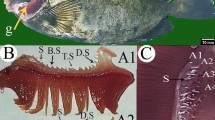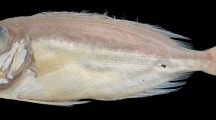Abstract
The pintado (Pseudoplatystoma coruscans) is a ferocious carnivorous catfish with evident cannibalistic behaviour; its nocturnal habits are related to its ability to use predominately chemical sensorial modalities. This study investigated whether the pintado distinguishes conspecifics of different body sizes using chemical cues, which may reflect different physiological conditions such as hunger or stress. Pintados were observed when receiving water conditioned by either larger or similar-size conspecifics. A control group consisted of pintados receiving unconditioned water. Twelve repetitions were used for each condition. Feeding-like behaviours were investigated in the receiver fish and showed that they responded only to the conditioned water. Furthermore, a higher frequency of responses occurred when the water was conditioned by a similar-size conspecific. Thus, it is concluded that pintados are able to recognize conspecific size by chemical cues related to size and that this ability contributes to the individual's decision making on whether to approach or to avoid the conspecific.

Similar content being viewed by others
References
Atema J (1971) Structure and functions of the sense of taste in the catfish (Ictalurus natalis). Brain Behav Evol 4:273–294
Beacham JL (1987) The relative importance of body size and aggressive experience as determinants of dominance in Pumpkinseed sunfish Lepomis gibbosus. Anim Behav 36:621–623
Bone Q, Marshall NB, Blaxter JHS (1995) Biology of fishes. Blackie Academic and Professional, London
Caprio J (1982) High sensitivity and specificity of olfactory and gustatory receptors of catfish. In: Hara TJ (ed) Chemoreception in fishes. Elsevier, Amsterdam, pp 257–283
Giaquinto PC, Volpato GL (1997) Chemical communication, aggression and conspecific recognition in the fish Nile tilapia. Physiol Behav 62:1333–1338
Giaquinto PC, Volpato GL (2001) Hunger suppresses the onset and the freezing component of the antipredator response to conspecific skin extract in pintado catfish. Behaviour 138:1213–1222
Grier JW (1984) Biology of animal behavior. Times Mirror/Mosby College Publishing, St. Louis, MO
Hartman EJ, Abrahams MV (2000) Sensory compensation and the detection of predators: the interaction between chemical and visual information. Proc R Soc London 267:571–575
Jachener A (2001) Anti-predator behavior of naïve compared with experienced juvenile roach. J Fish Biol 59:1313–1322
Johnsen PB, Teeter JH (1980) Spatial gradient detection of chemical cues by catfish. J Comp Physiol 140:95–99
Jordão LC, Volpato GL (2000) Chemical transfer of warning information in non-injured fish. Behaviour 137:681–690
Li K, Wetterer TJ, Hairston NG (1985) Fish size, visual resolution and prey selectivity. Ecology 66:1729–1735
Lopez CM, Alvim MC (1997) Larviculture of surubim Pseudoplatystoma coruscans Agassiz, 1829 (Siluriformes: Pimelodidae) in laboratory: a preliminary study. In: Val AL (ed) Proceedings of the international symposium of biology of tropical fishes, Manaus, Amazon, Brazil
Magurran AE, Higham A (1988) Information transfer across fish shoals under predator threat. Ethology 78:153–158
Magurran AE, Irving PW, Henderson PA (1996) Is there a fish alarm pheromone? A wild study and critique. Proc R Soc London B 263:1551–1556
Malyukina GA, Kasumyan AO, Marusov EA (1991) Ecological aspects of chemical signals in fish. J Ichthyology 31:1–7
Martin P, Bateson P (1993) Measuring behaviour: an introductory guide. Cambridge University Press, New York
Mathis A, Chivers DP, Smith RJF (1996) Cultural transmission of predator recognition in fishes: intraspecific and interspecific learning. Anim Behav 51:185–201
Petters G, Deventhal H, Klinger H (1980) Physiological and morphological effects of social stress in the eel (Anguilla anguilla). Arch Fischereiwiss 30:157–180
Pettersson LB, Nilsson PA, Bronmark C (2000) Predator recognition and defence strategies in crucian carp, Carassius carassius. Oikos 88:200–212
Pfeiffer W (1974) Pheromones in fish and amphibians. In: Birch MC (ed) Pheromones. Elsevier, Amsterdam, pp 269–296
Siegel S, Castellan NJ (1988) Nonparametric statistics for the behavioral sciences, 2nd edn. McGraw-Hill, New York
Smith RJF (1982) Alarm signals in fishes. Rev Fish Biol Fisher 2:33–63
Todd JH (1983) The chemical language of fishes. Sci Am 224:99–108
Unger PA, Lewis WM (1983) Selective predation with respect to body size in a population of the fish Xenomelaniris venezuele (Atherinidae). Ecology 64:1136–1144
Valentincic TB, Caprio J (1994) Chemical and visual control of feeding and escape behaviors in the channel catfish Ictalurus punctatus. Physiol Behav 55:845–855
Wisenden BD (2000) Scents of danger: the evolution of olfactory ornamentation in chemically-mediated predator–prey interactions. In: Espmark Y, Admundsen T, Rosenqvist G (eds) Animal signals: signaling and signal design in animal communication. Tapir Academic, Trondheim, Norway, pp 365–386
Wisenden BD, Smith RJF (1997) The effect of physical condition and shoalmate familiarity on proliferation of alarm substance cells in the epidermis of fathead minnows. J Fish Biol 50:799–808
Acknowledgements
We thank Mr. Antonio Carlos de Barros Tardivo for very helpful technical assistance and Mr. Ruy A. Bastos Freire Filho for skilful help during data acquisition. The research described was approved by the Committee on Animal Use and Supply at the University of São Paulo. The study was funded by a grant to P.C. Giaquinto from FAPESP (process no. 98/03036-4).
Author information
Authors and Affiliations
Corresponding author
Additional information
Communicated by R. Oliveira
Rights and permissions
About this article
Cite this article
Giaquinto, P.C., Volpato, G.L. Chemical cues related to conspecific size in pintado catfish, Pseudoplatystoma coruscans . acta ethol 8, 65–69 (2005). https://doi.org/10.1007/s10211-005-0001-3
Received:
Revised:
Accepted:
Published:
Issue Date:
DOI: https://doi.org/10.1007/s10211-005-0001-3




